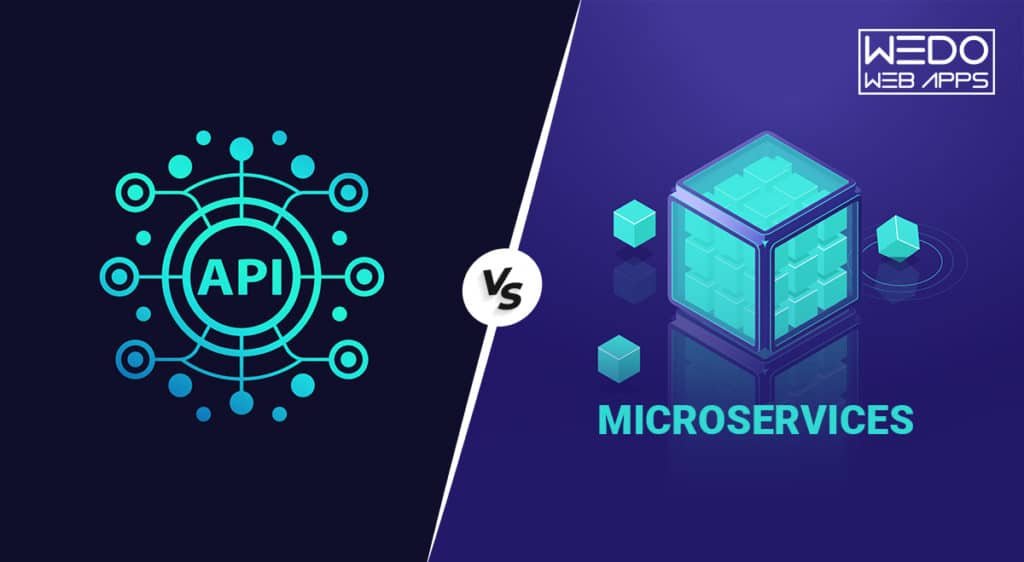17 Oct, 2023 | Mobile App Development
Comparing Microservices vs API: Which is Best for Software Design?

Key Takeaways
- Microservices and APIs are essential elements for creating flexible and scalable software architecture, providing a platform for services to communicate.
- Security measures such as OAuth 2.0 authentication and HTTPS encryption must be taken into account when implementing microservices & APIs.
- Choosing between the two requires evaluating factors like complexity, scalability, & security according to application needs.
Understanding Microservices
Microservices architecture is a way of approaching software applications that have deviated from the traditional monolithic model to be more agile and scalable, composed of smaller services dealing with different business capabilities. This method differs compared to service-oriented architectures as it affords developers greater control when handling modern systems complexities. The core elements needed for this type technology stack are APIs, Business Logic, Data Access Layer and Database - these make up the building blocks on which development teams can create independent services in their preferred programming languages. Allowing them increased flexibility plus data access so they can accomplish tasks quickly and effectively.Components of Microservices
The microservices architecture has revolutionized software development through its improved fault isolation. It is based on multiple APIs, which enable communication and integration between components in a seamless manner. Microservice-based applications consist of individual services, containers, service meshs for service discovery as well as an API gateway. All necessary elements to facilitate the smooth operation of each component within the application, be it state full or stateless ones. This monolithic approach helps developers accelerate production cycles while also simplifying maintenance tasks such as data access layer management and business logic implementation amongst other key aspects involved with development process improvement steps towards successful outcomes.Advantages of Microservices
Microservices architecture yields a range of advantages that affect the whole system, such as faster development cycles for independent services and increased ability to employ multiple technologies. This promotes team autonomy while also safeguarding data security and availability which helps organizations swiftly react to customer demands or market shifts. Technology diversity facilitates scalability in microservice based applications allowing greater flexibility when working with them at once. Altogether, this leads to an efficient yet resilient overall setup enabled by microservices architecture itself.Understanding APIs
Application Programming Interfaces (APIs) are software intermediaries that promote communication and data flow between diverse applications, by adhering to a set of guidelines regarding their usage. They form an integral part in connecting different components within the infrastructure such as benefits of microservices. APIs allow for distinct platforms to exchange information conveniently, promoting scalability while providing ease during app development processes through standardization tactics. Notably, web API facilitate integration between services developed using multiple programming languages. Thereby making it easier to blend different technologies into one application suite. This has made them irreplaceable tools today’s digital eco-systems rely on significantly due to these numerous advantages they offer: standardized approach capability , platform versatility , simplified process throughout development and so forth.Types of APIs
APIs can be divided into different groups, namely public, private or partner Audience APIs and REST, Graph or gRPC Architecture ones. Protocols include HTTP and Web Socket as well. Such software systems are commonly utilized for a variety of purposes like YouTube videos integration onto other sites. Trip planning websites acquiring up-to-date info on flights costs and times. Social networks logging in options through Google’s & Facebook’s API implementations. Plus navigation programs having access to live transit details provided by transit services’ APIs. GET requests along with PUT, DELETE.Advantages of APIs
APIs bring a multitude of advantages, such as uniformity in communication between diverse applications to simplify integration. The scalability offered by APIs makes it feasible for apps to be separated into smaller parts that can easily adapt with changes. Using APIs allow businesses an effortless way of incorporating new features and services which provide enhanced customer experiences including added payment gateways. Lastly, the simplified development process brought about by API implementation has transformed application creation across various platforms.Microservices and APIs: How They Interact
Microservices architecture is enhanced by the cooperation difference between microservices and APIs, which enables software systems to be efficient and adaptable. Microservice components are connected via APIs that facilitate data transfer for each component. This allows development cycles to speed up as well as making maintenance simpler. With an API in place, coordination of various services within a micro services structure is possible resulting increased scalability with flexible design options.Communication Mechanisms
Communication between microservices is a crucial part of ensuring their efficient contribution to the entire system. REST APIs are known for being standardized, language-independent and thus highly favored as they enable integration amongst services easily without compromising quality or capability. Synchronous and asynchronous messaging also facilitate two-way communication with APIs and one-way communication between the different components respectively, granting much needed flexibility in such complex systems that require specific requirements.API Design Principles for Microservices
For development teams utilizing microservices architecture, it is important to employ consistent design principles in order to create effective APIs. These include following best practices and employing common patterns like the single responsibility principle, decentralized data management, API-driven design, statelessness and loose coupling. Tools such as Swagger or Open API can be used for producing comprehensive documentation of these services which enhance software delivery capabilities while also making them easier to maintain over time. In sum proper use of well designed APIs helps streamline integration within a microservice context thus improving organizational performance overall.
Challenges in Implementing Microservices and APIs
Microservices and APIs offer a range of advantages, but also bring certain challenges that must be considered in order to maximize their potential. Development teams need an understanding of microservices and how they function together with APIs so as to effectively tackle the issues associated with them - such as security, monitoring & observability, versioning/backward compatibility, documentation and data consistency. By properly addressing these difficulties head-on. Development teams can benefit from using both technology types for optimal software system output.Security Considerations
In order to ensure a secure and reliable system, it is important for developers of microservices and APIs to implement authentication and authorization mechanisms such as OAuth 2.0 or JSON Web Tokens (JWT). This allows them to create a safe data exchange between services. Using HTTPS encryption in combination with good API key management Secures REST APIs. Taking these measures into account will give the software an added level of protection which preserves the integrity of information shared by means of microservices. Read also: 10 Secrets to Android app development to help your business growMonitoring and Observability
Monitoring and observability play a key role in the successful deployment and management of microservices and APIs. Developers should log, trace, and collect metrics to enable them to identify any problems quickly which could then be rectified immediately by their team for superior software delivery. This form of oversight Improves overall organizational performance as well ensuring that all associated technologies are working optimally at all times.Real-World Examples of Microservices and APIs
Real-world examples such as Amazon, Netflix, PayPal and Twitter are all proof of the effectiveness of microservices and APIs in scaling businesses to levels that may not have been reachable before. These companies show how technology can be leveraged to bring agility into a business while enjoying increased profits at the same time. The use cases presented by these successes illustrate just how powerful integrating microservices and APIs could be for modern software development – allowing developers more options when building their systems so they remain competitive on a global scale. From improved efficiency through scalability right down to driving growth within an increasingly digital environment. Understanding this concept is key if one wishes unlock its potential benefits for themselves or their organization. With comprehensive knowledge about harnessing power from API’s & Micro Services comes immense opportunities offering transformation where desired within system operations. Giving you unparalleled advantages over your competition which ultimately leads towards higher revenue streams with better ROI’s than ever before!Choosing Between Microservices and APIs
In order to make an informed decision between microservices and APIs, it is essential to consider the complexity, scalability, flexibility, performance integration needs of a specific application. benefits of Microservices architectures utilize APIs in order to enable communication and integration among services. Weighing all these factors can lead not only help developers choose between them but also provide beneficial improvements on software design as well as development & deployment procedures resulting with future growth prospects for their product or service.Summary
To sum up, the combination of microservices and APIs is becoming increasingly important in terms of software design. This powerful duo offer numerous advantages such as flexibility, scalability and efficiency that are essential for modern applications to stay ahead amid a rapidly changing digital world. When considering what type of approach to take it’s key to keep your project requirements at heart - understanding both their benefits and difficulties will allow you maximize these technologies potentials. Helping ensure prosperous outcomes for your organization’s future endeavors.Frequently Asked Questions
API is a key element for microservices architecture to operate and interact with other programs. By utilizing API, developers can include existing features into their code, thus creating an efficient design of multiple small services.
By following an API-First strategy, businesses can guarantee a smooth integration of their services across devices and operating systems. This approach enables developers to plan out APIs beforehand for efficient application development and maintenance. Conversely, microservices are single applications that have the capability to scale independently from one another. Hence with this technology in hand it is now easier than ever before for companies looking achieve seamless operations without worrying about device compatibility issues or similar obstructions along the way.
The benefits of adopting a microservices-based architecture are numerous, including more efficient performance and scalability as well as easier code reusability. On the flip side though, communication between these services needs to be managed correctly in order for them to function properly. This can complicate development and deployment processes while also driving up costs.
The essential parts of a microservice include an API, data access layer, business logic and database. All these components make up the core elements that provide necessary functionality for successful execution.
APIs can Be broken down into three distinct architectural types: REST, GraphQL and gRPC. All of these architectures provide a different way to transfer data between applications and systems.

